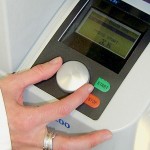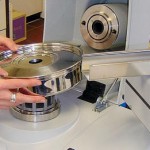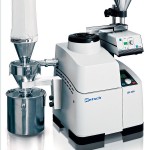In many laboratories, a great number of different samples are prepared day by day. For size reduction of solids down to analytical fineness, a mill is required which is not only versatile and easy to clean but which also ensures reproducible sample preparation and thus reliable analysis results.
The Author: Dr. Gerhard Beckers Application Support, Retsch
With the Ultra Centrifugal Mill ZM 200, Retsch offers a rotor mill which not only grinds quickly and very gently but is also suitable for many different applications, thanks to the wide selection of accessories. With its powerful drive, this mill grinds soft, medium-hard and fibrous materials extremely rapidly to a final fineness of less than 100 µm, thus increasing the sample throughput in the laboratory.
Functional principle and operation
Size reduction takes place by impact and shearing effects between the rotor and the fixed ring sieve. The feed material passes through the hopper (with splash-back protection) onto the rotor. Centrifugal acceleration throws it outwards with great energy and it is pre-crushed on impact with the wedge-shaped rotor teeth moving at a high speed. It is then finely ground between the rotor and the ring sieve. This two-step grinding ensures particularly gentle but fast processing. The feed material only remains in the grinding chamber for a very short time, which means that the characteristic features of the sample to be determined are not altered. The ground sample is collected in the cassette surrounding the grinding chamber or in the downstream cyclone or paper filter bag.
The Ultra Centrifugal Mill features an innovative operating concept which is very simple and safe for users. The parameters are easily set via a graphics display and one-button operation. The rotor speed can be set between 6000 and 18,000 min-1, which allows perfect adaptation to sample requirements. The drive load factor of the mill is shown graphically on the display. In combination with the high torque of the drive, this results in non-critical and rapid sample feeding without any risk of blocking the motor.
Efficient material handling
The feed material is introduced into the ZM 200 either manually or via an optional, load-controlled Vibratory Feeder DR 100, which is connected to the mill through an interface. The automatic, regular sample feed maximises the throughput without any risk of overloads and ensures uniform grinding results. When the sample is extracted, the ring sieve is automatically removed with the cassette. The patented cassette principle ensures easy and loss-free material removal and avoids cross-contamination.
The ZM 200 is easy and safe to use. The mill is equipped with splash-back protection to ensure safe grinding even of hard-brittle materials. Another important feature is the safety housing with automatic cover closure, i.e. the grinding chamber cover closes and unlocks automatically as soon as the grinding process has finished.
Small or large sample amounts
In many fields, the required sample amounts are very small. The mini-cassette for the ZM 200 for sample volumes of up to 20 ml, which is used in combination with the 8-tooth mini-rotor, is the ideal tool for such applications. All parts, including the cassette and the ring sieve, are made of corrosion-resistant 1.4404 steel.
For grinding larger volumes, a cyclone is available through which the sample passes into a 3 or 5 l collecting receptacle. The air drawn in from the rotor accelerates the discharge of the material, simultaneously discharging the heat produced by the grinding process and cooling the sample. If the cyclone is used for bigger sample amounts, the use of the load-controlled Vibratory Feeder DR 100 is recommended for material feed.
For thermally sensitive materials which, moreover, have specific characteristics that must not be altered by the heat produced during grinding, size reduction with the distance rotor is ideal. The gap between the rotor and the sieve plate is larger than with standard sieves. This helps to reduce the temperature in the grinding chamber and prevents the sample from melting at the ring sieve. This avoids loss of moisture and thermal degradation and ensures preservation of the sample properties to be determined.
Powder coating – a typical application
After the extrusion and cooling process, powder coatings consist of 1 to 2 mm chips with an edge length of approximately 5 to 10 mm. In the industrial production of the powder, rotor sifter mills are used to achieve a particle size between 10 and 90 µm. The quality of newly developed powder coatings and production batches needs to be analysed in the context of quality control. For this purpose, a larger amount of powder is required, which can be easily produced with the ZM 200. By using a 12-tooth rotor, distance sieves with different aperture sizes (0.08/0.12/0.2 and 0.25 mm, depending on the material properties), the cyclone separator and the Vibratory Feeder DR 100, several kilograms of powder coating with a particle size <63 µm can be produced in one pass.
Adaptation to sample requirements
The use of a ring sieve with a reinforced rim is recommended for tough materials. This prolongs the operating life of the sieve and allows hard materials to be ground as well.
For heavy-metal-free size reduction of non-abrasive materials, rotors and ring sieves made from titanium are advised together with a cassette and covers with a titanium-niobium coating. If abrasive samples are processed, grinding tools made of steel or titanium tend to wear out rather quickly; moreover, abrasion from the tools may falsify the analysis results. In such cases, grinding tools with a wear-resistant coating should be used. The special tungsten carbide coating on the rotors and ring sieves considerably reduces abrasion when grinding abrasive products.
It is generally difficult to pulverise thermally sensitive and elastic materials. After embrittlement with liquid nitrogen or dry ice, however, even these materials can be ground very finely.
Hall 7, Booth 340
Online-Info: www.cpp-net.com/0311416
Share:










